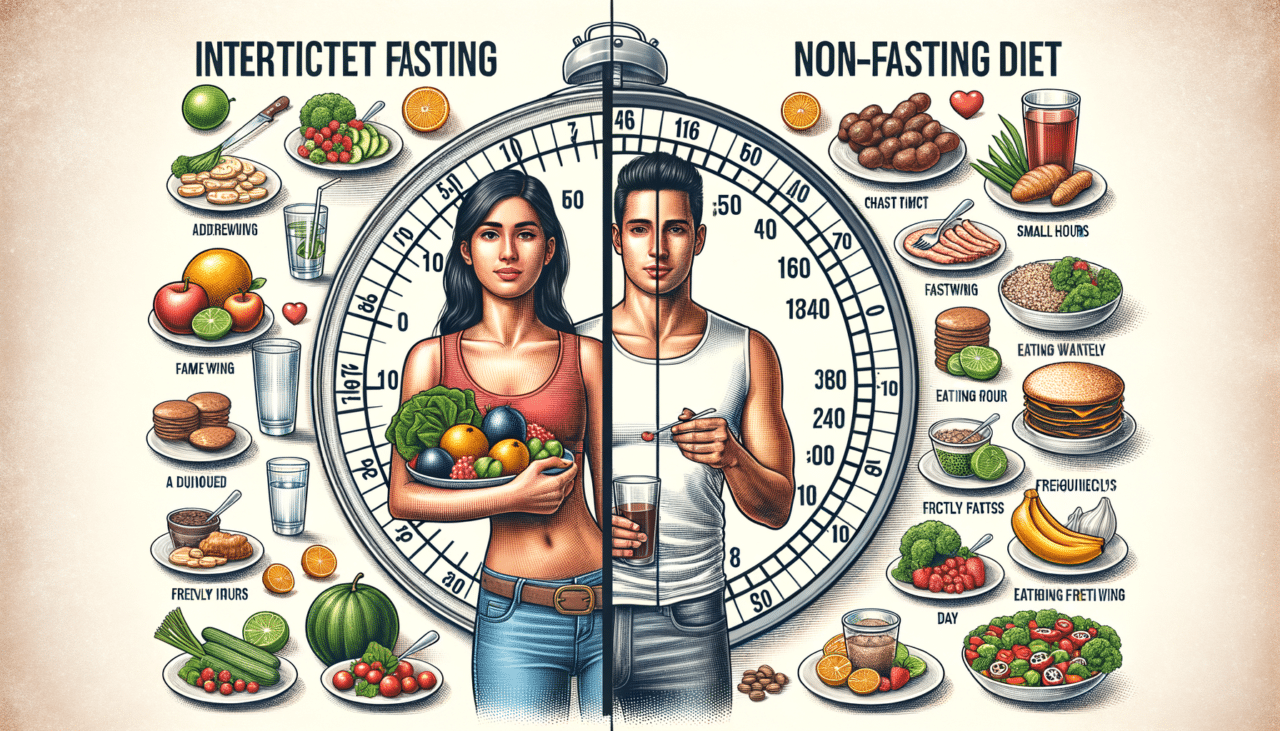Intermittent Fasting Diet vs. Non-Fasting Diet: Which Path Leads to a Healthier You?
In the bustling world of dietary trends and health optimization, two prominent paths often stand at the forefront: the Intermittent Fasting (IF) Diet and the Non-Fasting Diet. These dietary philosophies are as different as night and day, each offering a unique route to wellness. In this article, we will delve into the core characteristics of both diets, providing an in-depth comparison through a detailed table, and a narrative that paints a clearer picture of these lifestyle choices.
Imagine you’re at a crossroad, with two inviting paths leading to the same destination of better health. On one side, the Intermittent Fasting Diet beckons with promises of metabolic rejuvenation and simplicity. On the other, the Non-Fasting Diet offers consistency and flexibility. Which path should you choose? Let’s explore.
Intermittent Fasting Diet: A Time-Restricted Feast
Characteristics:
-
Structure and Simplicity: Intermittent Fasting is defined by its cyclical pattern of eating and fasting periods. Popular methods include the 16/8 method (fast for 16 hours, eat during an 8-hour window), the 5:2 diet (normal eating for 5 days, restricted calories for 2 days), and the Eat-Stop-Eat approach.
-
Health Benefits: This diet is praised for its potential to enhance metabolic health, promote fat loss, and improve insulin sensitivity. Some studies suggest it may also foster cellular repair processes and longevity.
-
Psychological Effects: For some, the reduced focus on meal planning can alleviate stress, while others may enjoy the mental clarity reported during fasting periods.
-
Challenges: Initial hunger pangs and social eating limitations can be hurdles. It requires a period of adaptation and may not suit everyone, especially those with certain medical conditions.
Non-Fasting Diet: Consistency and Freedom
Characteristics:
-
Flexibility and Variety: The Non-Fasting Diet focuses on regular meal consumption without strict time restrictions. It emphasizes balanced nutrition, portion control, and mindful eating.
-
Health Benefits: This approach supports stable energy levels, consistent nutrient intake, and can be tailored to specific dietary needs or preferences, such as vegetarianism or gluten-free diets.
-
Psychological Effects: The freedom to eat meals according to personal schedules can reduce anxiety around food. It allows for social interactions involving meals without the constraint of fasting windows.
-
Challenges: Without structured eating windows, there’s a potential risk of overeating or making less mindful food choices. It requires discipline in portion control and nutritional balance.
Comparative Table: Intermittent Fasting Diet vs. Non-Fasting Diet
| Feature | Intermittent Fasting Diet | Non-Fasting Diet |
|---|---|---|
| Structure | Cyclical eating and fasting periods | Regular meal consumption without time restrictions |
| Flexibility | Limited eating windows, more structured | High flexibility in meal timing and food variety |
| Metabolic Impact | Potentially enhances metabolic health and fat loss | Supports stable energy and nutrient intake |
| Psychological Effects | May improve mental clarity, less meal planning stress | Reduces food-related anxiety, allows for social meals |
| Adaptation Period | Requires adjustment to fasting periods | No significant adaptation period needed |
| Suitability | May not suit everyone, especially with medical conditions | Can be tailored to various dietary needs/preferences |
A Journey of Choices
Choosing between an Intermittent Fasting Diet and a Non-Fasting Diet is akin to selecting a travel route with distinct landscapes. One offers the thrill of structured discipline and periodic abstinence, potentially unlocking hidden metabolic highways. The other provides a scenic journey through the continuous fields of balanced meals and nutritional variety, ensuring that energy levels remain constant.
As you stand at this crossroads, consider your personal lifestyle, health goals, and psychological needs. Whether you choose the rhythmic dance of fasting or the steady beat of regular meals, both paths can lead to a healthier you. The key is to embark on a journey that aligns with your unique essence and aspirations.
In the end, the decision is deeply personal. Embrace the path that resonates with your lifestyle, and remember that the true destination is a healthier, happier you.

Comments (0)
There are no comments here yet, you can be the first!